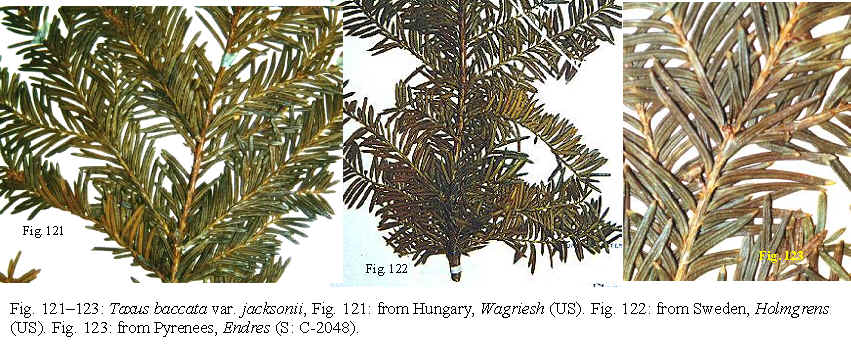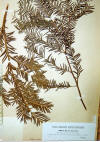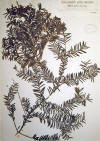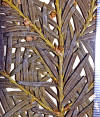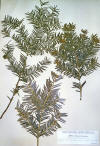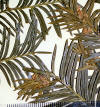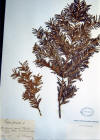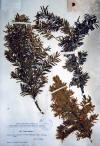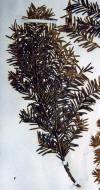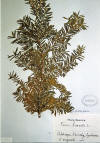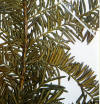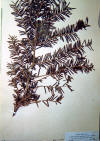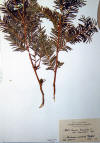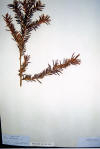1f. Taxus baccata var. jacksonii (Paul) Gordon, Pinet. Suppl. 99 (1862). Taxus. baccata jacksonii Paul, J. Hort. Soc. Lond. 493 (1861). Developed by William Paul in Cheshunt, England; origin of material unknown; original herbarium material unknown. Neotype Proposed—Sweden. Blekinge, Sjuhala—Holmgren, 6 Aug. 1925 at US! (US: 1276222; leaves with 8 stomata rows/band, abaxial marginal region lacking papillae across 5 rectangular cells, papillose across midrib, papillae medial). Jackson yew. Distribution: Euro-Mediterranean. Appearing to be trees with horizontal branches bearing long subpinnate branchlets, or occasionally with short branchlets, the branchlets pendulous or horizontal, often with a bright reddish orange tint; bud-scales conspicuous at base of branchlets, adpressed, deltoid, thickened medially but not conspicuously nerved, obtuse; leaves mostly spreading along two sides of straight horizontal branchlets, becoming erect on recurved or pendulous branchlets, overlapping slightly, especially near apex of branchlets, linear, falcate, obtuse to acute, 1.7–2.5 cm long, 1.5–2.5 mm wide, pale olive green above and pale yellowish orange below in herbarium specimens, plane to abruptly folded along margins; male cones reflexed, scattered on young branchlets, maturing just below apex; seeds usually maturing on 2 nd yr or older branchlets, occasionally on 1st yr branchlets, subcylindric to subglobose, orange to reddish brown. The Jackson yew is recognized by the relatively straight horizontal branches with long subpinnately arranged branchlets from which leaves spread widely along two sides (two-ranked). The leaf blades along the uppermost part of branchlets scarcely overlap the branchlets at their base in pressed specimens. The dried adaxial leaf surfaces appear pale olive green in color and are strongly convex. Additionally, branches in many specimens are notably orange in color, as also seen on the abaxial leaf surface. Taxus baccata var. jacksonii is similar to T. baccata var. variegata in branching, but the branches differ in their appearance of being less rigid with fewer erect leaves. The Jackson yew is also similar to T. cuspidata in the adaxial surface of leaves appearing rugose (dried specimens), and occasionally in other features such as leaves spreading upwards, leaves lacking papillae across more than 8 marginal cells, and seed on 2nd year or older growth. Taxus cuspidata is recognized, however, by leaves bending more abruptly near petiole, and by the cuspidate scales at base of branchlets, in contrast to the smaller obtuse scales of var. jacksonii. Representative Specimens—Spain/France: Pyrenees centr., montis Port de Bensque, Endrels Aug 1831 (K, S); ex Herb. Hook., 1867 (K); Batsmanshus Paroeciae Elfkarl, Rosalagiae abundans, Lagerheim & Sjogren, Jul 1844 (K). Switzerland: ex Herb. A. Gray (K). Austria: Tirol, Greolen (PH). Hungary: 445 m, Schönach 3084 (S: C-2061A; US, top left specimen of two); Vorarlbergia, 445 m, Wagriesh (US: 481917). Finland: Alandia, par. Lemland, in insula Jungfruskár, Vidlund, Finlandee Exsic. 419 (K, p.p., upper specimens). Syria: Düldül, Mt. Amanos, 1500–2000 m, Haradjan 3865 (S). Representative photos: Jardín botánico Mundani, http://jardin-mundani.info/taxaceae/teixC.jpg |
